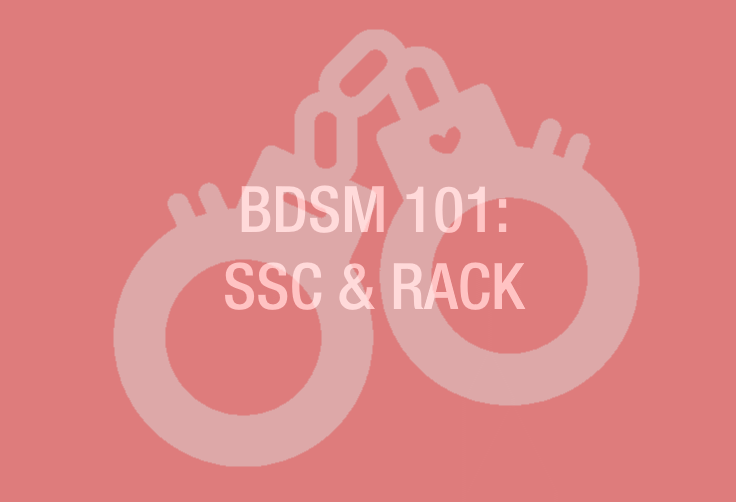⚖️ SSC vs. RACK: Foundations of Ethical Kink
In the world of BDSM, consent is king—but not all consent models are created equal. As the kink community has grown and evolved, so too have the philosophies that guide how we negotiate scenes, handle risk, and keep our play partners (and ourselves) safe.
Two of the most influential frameworks are Safe, Sane, and Consensual (SSC) and Risk-Aware Consensual Kink (RACK). While they share similar goals, they take different approaches to navigating risk, agency, and responsibility in BDSM.
Let’s break them down.
🔐 Safe, Sane, and Consensual (SSC)
Introduced in the 1980s, SSC was developed as a guiding principle to separate ethical kink from abusive behavior and challenge negative stereotypes of BDSM practitioners as dangerous or mentally unstable.
🌿 What SSC Stands For:
- Safe: All activities should avoid unnecessary harm and be as physically and emotionally secure as possible.
- Sane: Participants must be of sound mind and able to make rational decisions.
- Consensual: All play must be fully agreed upon by everyone involved, with informed, enthusiastic consent.
✅ Pros of SSC:
- Simple and easy to remember.
- Centers consent and safety as core values.
- Useful for introducing beginners to ethical kink.
⚠️ Criticisms of SSC:
- The term “sane” can feel ableist and dismissive of neurodivergent or mentally ill people who are still capable of consenting.
- “Safe” is subjective—many BDSM acts inherently carry some risk, which SSC tends to underemphasize.
- Can unintentionally stigmatize edgeplay (e.g., breathplay, knife play, blood play) as “insane” or irresponsible—even if negotiated and consensual.
⚠️ Risk-Aware Consensual Kink (RACK)
Developed in the late 1990s as a response to SSC, RACK acknowledges that BDSM isn’t always “safe” in the conventional sense—and that’s okay, as long as the risks are understood and accepted.
🖤 What RACK Stands For:
- Risk-Aware: Everyone involved understands the potential physical, emotional, and psychological risks of a given scene or dynamic.
- Consensual: Consent must still be present—but it’s informed consent, based on real knowledge of those risks.
- Kink: The focus remains on consensual, negotiated erotic practices that fall outside of vanilla sex.
✅ Pros of RACK:
- Honors informed adult agency: people can make conscious decisions to take risks in pursuit of intimacy, catharsis, or euphoria.
- Makes room for edgeplay and high-intensity kinks.
- Allows more nuanced, responsible discussions around power, trauma, and the limits of “safety.”
⚠️ Criticisms of RACK:
- More complex to explain, especially to beginners.
- Can be misused to excuse reckless behavior if participants aren’t genuinely informed or prepared.
- Places more responsibility on each person to self-educate and communicate honestly.
💡 So Which One Should You Use?
Neither is better—they serve different needs.
Some folks find SSC comforting, especially in early exploration. Others prefer RACK’s realism and autonomy once they dive deeper into the lifestyle.
Here’s a quick comparison:
| SSC | RACK | |
|---|---|---|
| Philosophy | Avoid Danger Entirely | Acknowledge and Accept risks |
| Approach | Prescriptive (what not to do) | Informed (what you choose to do) |
| Risk | Minimize or eliminate | Evaluate, discuss, and embrace responsibly |
| Audience | Beginners or those prioritizing safety | Experienced, edgeplayers, neurodivergent |
| Criticism | Overly simplistic and potentially Stigmatizing | Potentially misused, Complex to navigate |
🧠 Consent Isn’t a One-Time Checkbox
Both models agree on one thing: Consent must be informed, ongoing, and enthusiastic. Whether you follow SSC, RACK, or a hybrid (some even use PRICK: Personal Responsibility Informed Consensual Kink), your ethical compass should always include:
- Clear communication
- Regular check-ins
- Emotional awareness
- Safe words or signals
- Boundaries that are respected and never negotiated under pressure
🖋️ Final Thoughts
In the end, BDSM isn’t about playing it “safe” or “risky”—it’s about being aware, respectful, and deliberate with how we give and receive power.
These frameworks aren’t rigid rules—they’re tools to help us play with integrity and joy.
So whether you’re tying someone up or giving up control, remember: it’s not just about the kink. It’s about intentional connection. Choose your framework. Educate yourself. And, above all—
Play smart. Play kind. Play consensually.



